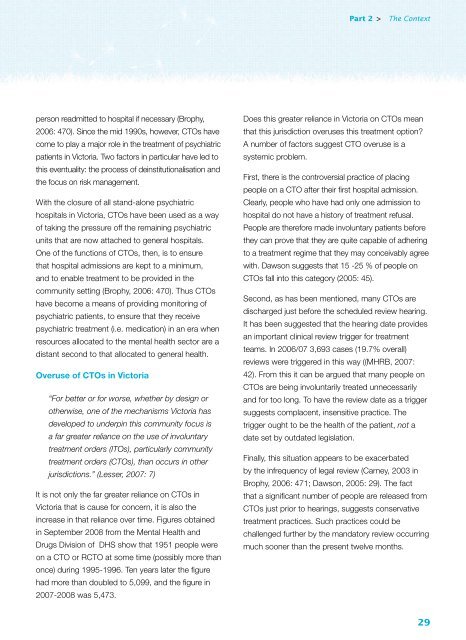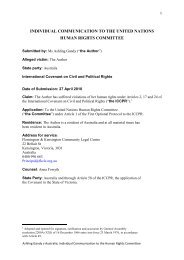Lacking Insight - Community Law
Lacking Insight - Community Law
Lacking Insight - Community Law
- No tags were found...
Create successful ePaper yourself
Turn your PDF publications into a flip-book with our unique Google optimized e-Paper software.
Part 2 > The Contextperson readmitted to hospital if necessary (Brophy,2006: 470). Since the mid 1990s, however, CTOs havecome to play a major role in the treatment of psychiatricpatients in Victoria. Two factors in particular have led tothis eventuality: the process of deinstitutionalisation andthe focus on risk management.With the closure of all stand-alone psychiatrichospitals in Victoria, CTOs have been used as a wayof taking the pressure off the remaining psychiatricunits that are now attached to general hospitals.One of the functions of CTOs, then, is to ensurethat hospital admissions are kept to a minimum,and to enable treatment to be provided in thecommunity setting (Brophy, 2006: 470). Thus CTOshave become a means of providing monitoring ofpsychiatric patients, to ensure that they receivepsychiatric treatment (i.e. medication) in an era whenresources allocated to the mental health sector are adistant second to that allocated to general health.Overuse of CTOs in Victoria“For better or for worse, whether by design orotherwise, one of the mechanisms Victoria hasdeveloped to underpin this community focus isa far greater reliance on the use of involuntarytreatment orders (ITOs), particularly communitytreatment orders (CTOs), than occurs in otherjurisdictions.” (Lesser, 2007: 7)It is not only the far greater reliance on CTOs inVictoria that is cause for concern, it is also theincrease in that reliance over time. Figures obtainedin September 2008 from the Mental Health andDrugs Division of DHS show that 1951 people wereon a CTO or RCTO at some time (possibly more thanonce) during 1995-1996. Ten years later the figurehad more than doubled to 5,099, and the figure in2007-2008 was 5,473.Does this greater reliance in Victoria on CTOs meanthat this jurisdiction overuses this treatment option?A number of factors suggest CTO overuse is asystemic problem.First, there is the controversial practice of placingpeople on a CTO after their first hospital admission.Clearly, people who have had only one admission tohospital do not have a history of treatment refusal.People are therefore made involuntary patients beforethey can prove that they are quite capable of adheringto a treatment regime that they may conceivably agreewith. Dawson suggests that 15 -25 % of people onCTOs fall into this category (2005: 45).Second, as has been mentioned, many CTOs aredischarged just before the scheduled review hearing.It has been suggested that the hearing date providesan important clinical review trigger for treatmentteams. In 2006/07 3,693 cases (19.7% overall)reviews were triggered in this way ((MHRB, 2007:42). From this it can be argued that many people onCTOs are being involuntarily treated unnecessarilyand for too long. To have the review date as a triggersuggests complacent, insensitive practice. Thetrigger ought to be the health of the patient, not adate set by outdated legislation.Finally, this situation appears to be exacerbatedby the infrequency of legal review (Carney, 2003 inBrophy, 2006: 471; Dawson, 2005: 29). The factthat a significant number of people are released fromCTOs just prior to hearings, suggests conservativetreatment practices. Such practices could bechallenged further by the mandatory review occurringmuch sooner than the present twelve months.29
















